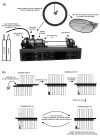Oxygen Dependence of Flight Performance in Ageing Drosophila melanogaster
- PMID: 33919761
- PMCID: PMC8070683
- DOI: 10.3390/biology10040327
Oxygen Dependence of Flight Performance in Ageing Drosophila melanogaster
Abstract
Similar to humans, insects lose their physical and physiological capacities with age, which makes them a convenient study system for human ageing. Although insects have an efficient oxygen-transport system, we know little about how their flight capacity changes with age and environmental oxygen conditions. We measured two types of locomotor performance in ageing Drosophila melanogaster flies: the frequency of wing beats and the capacity to climb vertical surfaces. Flight performance was measured under normoxia and hypoxia. As anticipated, ageing flies showed systematic deterioration of climbing performance, and low oxygen impeded flight performance. Against predictions, flight performance did not deteriorate with age, and younger and older flies showed similar levels of tolerance to low oxygen during flight. We suggest that among different insect locomotory activities, flight performance deteriorates slowly with age, which is surprising, given that insect flight is one of the most energy-demanding activities in animals. Apparently, the superior capacity of insects to rapidly deliver oxygen to flight muscles remains little altered by ageing, but we showed that insects can become oxygen limited in habitats with a poor oxygen supply (e.g., those at high elevations) during highly oxygen-demanding activities such as flight.
Keywords: ageing; climbing; hypoxia; insects; locomotor activity; oxygen limitation; physiological performance; senescence; wing load; wing-beat frequency.
Conflict of interest statement
The authors declare no conflict of interest. The funders had no role in the design of the study; in the collection, analyses, or interpretation of data; in the writing of the manuscript; or in the decision to publish the results.
Figures



Similar articles
-
Thermal and Oxygen Flight Sensitivity in Ageing Drosophila melanogaster Flies: Links to Rapamycin-Induced Cell Size Changes.Biology (Basel). 2021 Sep 2;10(9):861. doi: 10.3390/biology10090861. Biology (Basel). 2021. PMID: 34571738 Free PMC article.
-
More oxygen during development enhanced flight performance but not thermal tolerance of Drosophila melanogaster.PLoS One. 2017 May 23;12(5):e0177827. doi: 10.1371/journal.pone.0177827. eCollection 2017. PLoS One. 2017. PMID: 28542380 Free PMC article.
-
Genetic Variability of Flight Metabolism in DROSOPHILA MELANOGASTER. I. Characterization of Power Output during Tethered Flight.Genetics. 1981 Jul;98(3):549-64. doi: 10.1093/genetics/98.3.549. Genetics. 1981. PMID: 17249099 Free PMC article.
-
Does oxygen limit thermal tolerance in arthropods? A critical review of current evidence.Comp Biochem Physiol A Mol Integr Physiol. 2016 Feb;192:64-78. doi: 10.1016/j.cbpa.2015.10.020. Epub 2015 Oct 24. Comp Biochem Physiol A Mol Integr Physiol. 2016. PMID: 26506130 Free PMC article. Review.
-
Thermoregulation in endothermic insects.Science. 1974 Aug 30;185(4153):747-56. doi: 10.1126/science.185.4153.747. Science. 1974. PMID: 4602075 Review.
Cited by
-
Thermal and Oxygen Flight Sensitivity in Ageing Drosophila melanogaster Flies: Links to Rapamycin-Induced Cell Size Changes.Biology (Basel). 2021 Sep 2;10(9):861. doi: 10.3390/biology10090861. Biology (Basel). 2021. PMID: 34571738 Free PMC article.
-
Sexual dimorphism and the impact of aging on ball rolling-associated locomotor behavior in Drosophila.Biol Open. 2024 Nov 15;13(11):bio060609. doi: 10.1242/bio.060609. Epub 2024 Nov 13. Biol Open. 2024. PMID: 39434609 Free PMC article.
-
How does a fly die? Insights into ageing from the pathophysiology of Drosophila mortality.Geroscience. 2024 Oct;46(5):4003-4015. doi: 10.1007/s11357-024-01158-4. Epub 2024 Apr 20. Geroscience. 2024. PMID: 38642259 Free PMC article. Review.
-
The Drosophila melanogaster ACE2 ortholog genes are differently expressed in obesity/diabetes and aging models: Implications for COVID-19 pathology.Biochim Biophys Acta Mol Basis Dis. 2022 Dec 1;1868(12):166551. doi: 10.1016/j.bbadis.2022.166551. Epub 2022 Sep 15. Biochim Biophys Acta Mol Basis Dis. 2022. PMID: 36116726 Free PMC article.
-
Measuring the repertoire of age-related behavioral changes in Drosophila melanogaster.PLoS Comput Biol. 2022 Feb 24;18(2):e1009867. doi: 10.1371/journal.pcbi.1009867. eCollection 2022 Feb. PLoS Comput Biol. 2022. PMID: 35202388 Free PMC article.
References
-
- Alexander D.E. On the Wing. Oxford University Press; New York, NY, USA: 2015.
-
- Jenni-Eiermann S., Srygley R.B. In: Physiological Aeroecology: Anatomical and Physiological Adaptations for Flight. Chilson P., Frick W., Kelly J., Liechti F., editors. Springer; Cham, Switzerland: 2017.
-
- Beenakkers A.M.T., Van der Horst D.J., Van Marrewijk W.J.A. Insect flight muscle metabolism. Insect Biochem. 1984;14:243–260. doi: 10.1016/0020-1790(84)90057-X. - DOI
Grants and funding
LinkOut - more resources
Full Text Sources
Other Literature Sources
Molecular Biology Databases
Research Materials

